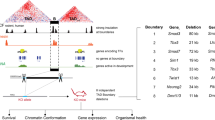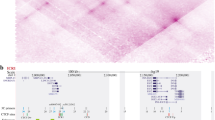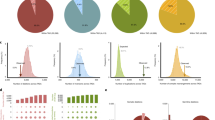Abstract
Chromosome conformation capture methods have identified subchromosomal structures of higher-order chromatin interactions called topologically associated domains (TADs) that are separated from each other by boundary regions1,2. By subdividing the genome into discrete regulatory units, TADs restrict the contacts that enhancers establish with their target genes3,4,5. However, the mechanisms that underlie partitioning of the genome into TADs remain poorly understood. Here we show by chromosome conformation capture (capture Hi-C and 4C-seq methods) that genomic duplications in patient cells and genetically modified mice can result in the formation of new chromatin domains (neo-TADs) and that this process determines their molecular pathology. Duplications of non-coding DNA within the mouse Sox9 TAD (intra-TAD) that cause female to male sex reversal in humans6, showed increased contact of the duplicated regions within the TAD, but no change in the overall TAD structure. In contrast, overlapping duplications that extended over the next boundary into the neighbouring TAD (inter-TAD), resulted in the formation of a new chromatin domain (neo-TAD) that was isolated from the rest of the genome. As a consequence of this insulation, inter-TAD duplications had no phenotypic effect. However, incorporation of the next flanking gene, Kcnj2, in the neo-TAD resulted in ectopic contacts of Kcnj2 with the duplicated part of the Sox9 regulatory region, consecutive misexpression of Kcnj2, and a limb malformation phenotype. Our findings provide evidence that TADs are genomic regulatory units with a high degree of internal stability that can be sculptured by structural genomic variations. This process is important for the interpretation of copy number variations, as these variations are routinely detected in diagnostic tests for genetic disease and cancer. This finding also has relevance in an evolutionary setting because copy-number differences are thought to have a crucial role in the evolution of genome complexity.
This is a preview of subscription content, access via your institution
Access options
Subscribe to this journal
Receive 51 print issues and online access
$199.00 per year
only $3.90 per issue
Buy this article
- Purchase on Springer Link
- Instant access to full article PDF
Prices may be subject to local taxes which are calculated during checkout




Similar content being viewed by others
Accession codes
References
Nora, E. P. et al. Spatial partitioning of the regulatory landscape of the X-inactivation centre. Nature 485, 381–385 (2012)
Dixon, J. R. et al. Topological domains in mammalian genomes identified by analysis of chromatin interactions. Nature 485, 376–380 (2012)
Lupiáñez, D. G. et al. Disruptions of topological chromatin domains cause pathogenic rewiring of gene-enhancer interactions. Cell 161, 1012–1025 (2015)
Symmons, O. et al. Functional and topological characteristics of mammalian regulatory domains. Genome Res. 24, 390–400 (2014)
Rao, S. S. et al. A 3D map of the human genome at kilobase resolution reveals principles of chromatin looping. Cell 159, 1665–1680 (2014)
Benko, S. et al. Disruption of a long distance regulatory region upstream of SOX9 in isolated disorders of sex development. J. Med. Genet. 48, 825–830 (2011)
Wagner, T. et al. Autosomal sex reversal and campomelic dysplasia are caused by mutations in and around the SRY-related gene SOX9. Cell 79, 1111–1120 (1994)
Kurth, I. et al. Duplications of noncoding elements 5′ of SOX9 are associated with brachydactyly-anonychia. Nature Genet. 41, 862–863 (2009)
Gordon, C. T. et al. Long-range regulation at the SOX9 locus in development and disease. J. Med. Genet. 46, 649–656 (2009)
Kim, G.-J. et al. Copy number variation of two separate regulatory regions upstream of SOX9 causes isolated 46,XY or 46,XX disorder of sex development. J. Med. Genet. 52, 240–247 (2015)
Sekido, R. & Lovell-Badge, R. Sex determination involves synergistic action of SRY and SF1 on a specific Sox9 enhancer. Nature 453, 930–934 (2008)
Dahal, G. R. et al. An inwardly rectifying K+ channel is required for patterning. Development 139, 3653–3664 (2012)
Mundlos, S. The brachydactylies: a molecular disease family. Clin. Genet. 76, 123–136 (2009)
Sanborn, A. L. et al. Chromatin extrusion explains key features of loop and domain formation in wild-type and engineered genomes. Proc. Natl Acad. Sci. USA 112, E6456–E6465 (2015)
Guo, Y. et al. CRISPR inversion of CTCF sites alters genome topology and enhancer/promoter function. Cell 162, 900–910 (2015)
Lupski, J. R. Genomic rearrangements and sporadic disease. Nature Genet. 39 (Suppl), S43–S47 (2007)
Stephens, P. J. et al. Complex landscapes of somatic rearrangement in human breast cancer genomes. Nature 462, 1005–1010 (2009)
Ohno, S. Evolution by Gene Duplication (Springer, 1970)
Katju, V. & Bergthorsson, U. Copy-number changes in evolution: rates, fitness effects and adaptive significance. Front. Genet. 4, 273 (2013)
Kraft, K. et al. Deletions, inversions, duplications: engineering of structural variants using CRISPR/Cas in Mice. Cell Reports 10, 833–839 (2015)
Artus, J. & Hadjantonakis, A.-K. in Transgenic Mouse Methods and Protocols Vol. 693 Methods in Molecular Biology (eds Hofker, M. H. & van Deursen, J. ) Ch. 3, 37–56 (Humana Press, 2011)
Ruf, S. et al. Large-scale analysis of the regulatory architecture of the mouse genome with a transposon-associated sensor. Nature Genet. 43, 379–386 (2011)
Hooper, M., Hardy, K., Handyside, A., Hunter, S. & Monk, M. HPRT-deficient (Lesch–Nyhan) mouse embryos derived from germline colonization by cultured cells. Nature 326, 292–295 (1987)
Nagy, K. & Nichols, J. in Advanced Protocols for Animal Transgenesis (eds Pease, S . & Saunders, T. L. ) Ch. 18, 431–455 (Springer, 2011)
van de Werken, H. J. G. et al. in Methods in Enzymology Vol. 513 (eds Wu, C. & Allis, D. C. ) 89–112 (Academic Press, 2012)
Li, H. & Durbin, R. Fast and accurate short read alignment with Burrows–Wheeler transform. Bioinformatics 25, 1754–1760 (2009)
McKenna, A. et al. The Genome Analysis Toolkit: a MapReduce framework for analyzing next-generation DNA sequencing data. Genome Res. 20, 1297–1303 (2010)
Wingett, S. et al. HiCUP: pipeline for mapping and processing Hi-C data. F1000Res. 4, 1310 (2015)
Langmead, B. & Salzberg, S. L. Fast gapped-read alignment with Bowtie 2. Nat. Methods 9, 357–359 (2012)
Zhou, X. et al. Exploring long-range genome interactions using the WashU Epigenome Browser. Nature Methods 10, 375–376 (2013)
Dobin, A. et al. STAR: ultrafast universal RNA-seq aligner. Bioinformatics 29, 15–21 (2013)
Love, M. I., Huber, W. & Anders, S. Moderated estimation of fold change and dispersion for RNA-seq data with DESeq2. Genome Biol. 15, 550 (2014)
Bhatia, S. et al. Functional assessment of disease-associated regulatory variants in vivo using a versatile dual colour transgenesis strategy in zebrafish. PLoS Genet. 11, e1005193 (2015)
Benko, S. et al. Highly conserved non-coding elements on either side of SOX9 associated with Pierre Robin sequence. Nature Genet. 41, 359–364 (2009)
Visel, A., Minovitsky, S., Dubchak, I. & Pennacchio, L. A. VISTA Enhancer Browser—a database of tissue-specific human enhancers. Nucleic Acids Res. 35, D88–D92 (2007)
Gordon, C. T. et al. Identification of novel craniofacial regulatory domains located far upstream of SOX9 and disrupted in Pierre Robin sequence. Hum. Mutat. 35, 1011–1020 (2014)
Yao, B. et al. The SOX9 upstream region prone to chromosomal aberrations causing campomelic dysplasia contains multiple cartilage enhancers. Nucleic Acids Res. 43, 5394–5408 (2015)
Acknowledgements
We are grateful to all members of the MPIMG transgene and mouse facility for embryonic stem cell aggregation and mouse husbandry. This work was supported by grants from the Deutsche Forschungsgemeinschaft to S.M. and F.S., the BIH to D.M.I., S.M. and A.P., and the Max Planck Foundation to S.M.
Author information
Authors and Affiliations
Contributions
M.F., F.S. and S.M. conceived the study and designed the experiments. M.F. and G.A. performed 4C-seq, capture Hi-C, with analysis by V.H., D.M.I. and R.S. M.F. and W.S. performed the LacZ staining and analysis. M.F. and D.M.I. performed RNA-seq, in situ hybridizations and phenotype analysis. W.-L.C. and I.J. contributed to histological analysis. M.F., W.S., R.K., D.M.I., K.K. and L.W. generated the transgenic mouse models. I.K., P.C., O.Z., G.H., M.S., L.L. and F.B. obtained the patient samples. A.P., W.S., F.S., M.S., M.V. and B.T. contributed to scientific discussion and technical support. M.F., D.M.I. and S.M. wrote the paper with input from all authors.
Corresponding author
Ethics declarations
Competing interests
The authors declare no competing financial interests.
Additional information
Sequencing data has been deposited in Gene Expression Omnibus (GEO) under GSE78109.
Reviewer Information Nature thanks B. Ren and the other anonymous reviewer(s) for their contribution to the peer review of this work.
Extended data figures and tables
Extended Data Figure 1 4C-seq from patient fibroblasts with a 470 kb intra-TAD duplication (sex reversal).
Schematic representation depicts TAD structure with KCNJ TAD (blue), SOX9 TAD (brown) and TAD boundaries (red hexagons). Size and position of the 470 kb intra-TAD duplication in a patient with female-to-male sex reversal is indicated by the overlap. Patient fibroblasts were derived from a gonadal biopsy of ovo-testes. 4C-seq tracks below show interaction profiles from SOX9 (brown), KCNJ2 (blue) and breakpoint (purple) viewpoint. Note interaction profiles from SOX9 and KCNJ2 are restricted to their corresponding TADs. Unique viewpoint at the breakpoint shows that interactions are restricted to the SOX9 TAD. Note all reads mapped to a wild-type genome resulting in split viewpoint for the duplication breakpoint.
Extended Data Figure 2 Allele frequencies determined in 4C-seq data indicate selective interactions in a patient with an inter-TAD duplication (no phenotype).
SNP analysis related to Fig. 1d. a, Schematic of SNP-analysis in a patient carrying an inter-TAD duplication (heterozygous) with no phenotype. SNP positions and their allele frequency (AF) identified by whole-genome sequencing from the patient are shown. Bottom, 4C-seq interaction profiles using SOX9 (brown), KCNJ2 (blue) and the duplication breakpoint (purple) as viewpoints (triangles). SNPs contacted by individual viewpoints are indicated. Note that variants contacted by the breakpoint viewpoint are not contacted by SOX9 and KCNJ2 viewpoints, suggesting the formation of an insulated interaction domain (purple). b, Summary of observed SNP genotype and allele frequency from whole-genome sequencing data and 4C-seq viewpoints.
Extended Data Figure 3 4C-seq from an inter-TAD duplication in Dup-L mouse mutants.
a, Schematic representation depicts TAD structure in wild type with Kcnj TAD (blue), Sox9 TAD (brown) and TAD boundaries (red hexagons). Below, 4C-seq interaction profiles of viewpoints (triangles) in Sox9 (brown) and Kcnj2 (blue) from E12.5 wild-type limb buds. b, Schematic representation of Dup-L allele. Position of lacZ reporter at the duplication breakpoint is shown and duplication is indicated by overlap. Note that 4C-seq reads are mapped to the wild-type genome, which results in split viewpoint from lacZ viewpoint. 4C-seq profiles with viewpoint in Sox9 (brown), Kcnj2 (blue) and lacZ reporter (purple) in Dup-L are shown below. Kcnj2 and Sox9 profiles are unchanged, whereas the unique viewpoint in the lacZ reporter shows interactions that are restricted to the duplicated region, suggesting formation of a separate interaction domain.
Extended Data Figure 4 Overview of mouse alleles used in this study.
The extent of each duplicated and deleted region in mice are given as mm9 coordinates. Observed mouse phenotypes and human syndromes with the equivalent mutation are listed. For generation of alleles see Methods. SB, Sleeping Beauty transgene containing a single loxP site (red) and a lacZ reporter gene (blue) flanked by SB-transposons.
Extended Data Figure 5 4C-seq interaction profile of neo-TAD in Dup-L mutants resembles profiles from Sox9 and Kcnj2 viewpoints.
a, The position of published in vivo tested reporter constructs11,33,34,35,36,37 and active chromatin marks (H3K4me1/H3K27ac positive) in Sox9-expressing tissue (mouse ENCODE project) are indicated above the 4C tracks. The only known enhancer driving testis-specific expression, TESCO, is indicated. 4C-seq interaction profiles from Kcnj2 (blue) and Sox9 (brown) in wild type and from the lacZ reporter gene (purple) in E12.5 Dup-L mutants are shown. Triangles indicate viewpoints. Note that 4C-seq reads are mapped to the wild-type genome resulting in split viewpoint from the lacZ viewpoint. The interaction profile from lacZ viewpoint located at the breakpoint of the Dup-L duplication shows a similar pattern and peak distribution (dashed boxes) as the Sox9 and Kcnj2 viewpoints. Note similarities of peak profiles at the boundary between Kcnj and Sox9 TADs (arrows in red dashed box). b, Schematic of locus with an artificially duplicated region and corresponding 4C-seq profile from the lacZ viewpoint inside the neo-TAD in Dup-L mutants. The centromeric and telomeric part of the tandem duplication is indicated. The purple 4C-seq profile corresponds to the neo-TAD delimited by the duplicated TAD boundary.
Extended Data Figure 6 4C-seq of inter-TAD Cooks syndrome duplications in mouse and human.
Extent and position of the duplications is indicated by the overlap in the schematic. 4C-seq profiles with indicated viewpoints and ratio to control (below) a, Sox9 (brown) and Kcnj2 (blue) 4C-seq from Dup-C mutant limb buds at E12.5. b, 4C-seq from fibroblasts of an individual with Cooks syndrome and inter-TAD duplication from SOX9 and KCNJ2 viewpoints. Below, 4C-seq with viewpoint in KCNJ16 (light blue) in patient and control fibroblasts and the ratio of patient to control. a, b, Incorporation of Kcnj/KCNJ genes in the neo-TAD results in ectopic contacts from the Kcnj2 or KCNJ2 and KCNJ16 viewpoints with the duplicated part of the Sox9 TAD, whereas interactions from the Sox9/SOX9 viewpoint remain unchanged.
Extended Data Figure 7 RNA-seq analysis of genes at the Sox9, Kcnj2 and Kcnj16 locus from mouse mutants used in this study.
a, b, RNA-seq from wild-type and mutant E12.5 limb buds and E17.5 fingertips (lower two tracks) shows read profiles for Kcnj16, Kcnj2 and Sox9. Note the absence of expression of Kcnj16 in the examined tissue. c, Summary of expression values of genes at the Sox9, Kcnj2 and Kcnj16 locus from E12.5 limb buds. Significant expression changes are in bold. FPKM, fragments per kilobase of exon per million fragments mapped. Benjamini–Hochberg-adjusted P value, n = 2, cut-off = 0.001.
Extended Data Figure 8 Deletion of the TAD boundary region in wild-type and Dup-L mutant mice.
a, Left, cHi-C from wild type (top) and ∆Bor (middle) E12.5 limb buds and subtraction map of ∆Bor relative to wild type (bottom). Deletion of the boundary between the Kcnj and Sox9 TADs leads to loss of insulation and ectopic interactions (*) between the TADs. Note overall TAD structure remains intact and ectopic interaction is restricted by remaining TAD boundaries. Right, cHi-C from Dup-L (top) and Dup-L∆Bor (middle) E12.5 limb buds and subtraction map of Dup-L∆Bor relative to Dup-L (bottom). Deletion of the two duplicated boundary regions flanking the neo-TAD, results in ectopic contacts of duplicated sequences with adjacent Kcnj and Sox9 TADs (*) including Sox9 and Kcnj2, as seen in ∆Bor mutants. Loss of neo-TAD insulation results in increased interactions of the duplicated sequences (**). b, Expression analysis of Sox9 and Kcnj2 in wild-type, ∆Bor and Dup-L∆Bor embryos. RNA-seq expression analysis of mutant versus wild-type E12.5 limb buds. Kcnj2 is upregulated in ∆Bor (heterozygous and homozygous) and Dup-L∆Bor (homozygous) limb buds (Benjamini-Hochberg adjusted P values, n = 2). Whole mount in situ hybridization shows no site-specific misexpression of Kcnj2 in a Sox9-like pattern.
Supplementary information
Supplementary Table 1
This file contains sequences of guide RNAs für CRISPR/Cas9 experiments and primer sequences for cloning of gene targeting constructs and probes for in situ hybridization. (XLSX 31 kb)
Supplementary Table 2
This table contains 4C-seq primer sequences for inverse PCR and digestion strategy for 4C library preparation. (XLSX 10 kb)
Rights and permissions
About this article
Cite this article
Franke, M., Ibrahim, D., Andrey, G. et al. Formation of new chromatin domains determines pathogenicity of genomic duplications. Nature 538, 265–269 (2016). https://doi.org/10.1038/nature19800
Received:
Accepted:
Published:
Issue Date:
DOI: https://doi.org/10.1038/nature19800
This article is cited by
-
Giant pandas in captivity undergo short-term adaptation in nerve-related pathways
BMC Zoology (2024)
-
Kdm1a safeguards the topological boundaries of PRC2-repressed genes and prevents aging-related euchromatinization in neurons
Nature Communications (2024)
-
A distant global control region is essential for normal expression of anterior HOXA genes during mouse and human craniofacial development
Nature Communications (2024)
-
Co-localization of clusters of TCR-regulated genes with TAD rearrangements
BMC Genomics (2023)
-
Hi-C analysis of genomic contacts revealed karyotype abnormalities in chicken HD3 cell line
BMC Genomics (2023)
Comments
By submitting a comment you agree to abide by our Terms and Community Guidelines. If you find something abusive or that does not comply with our terms or guidelines please flag it as inappropriate.



